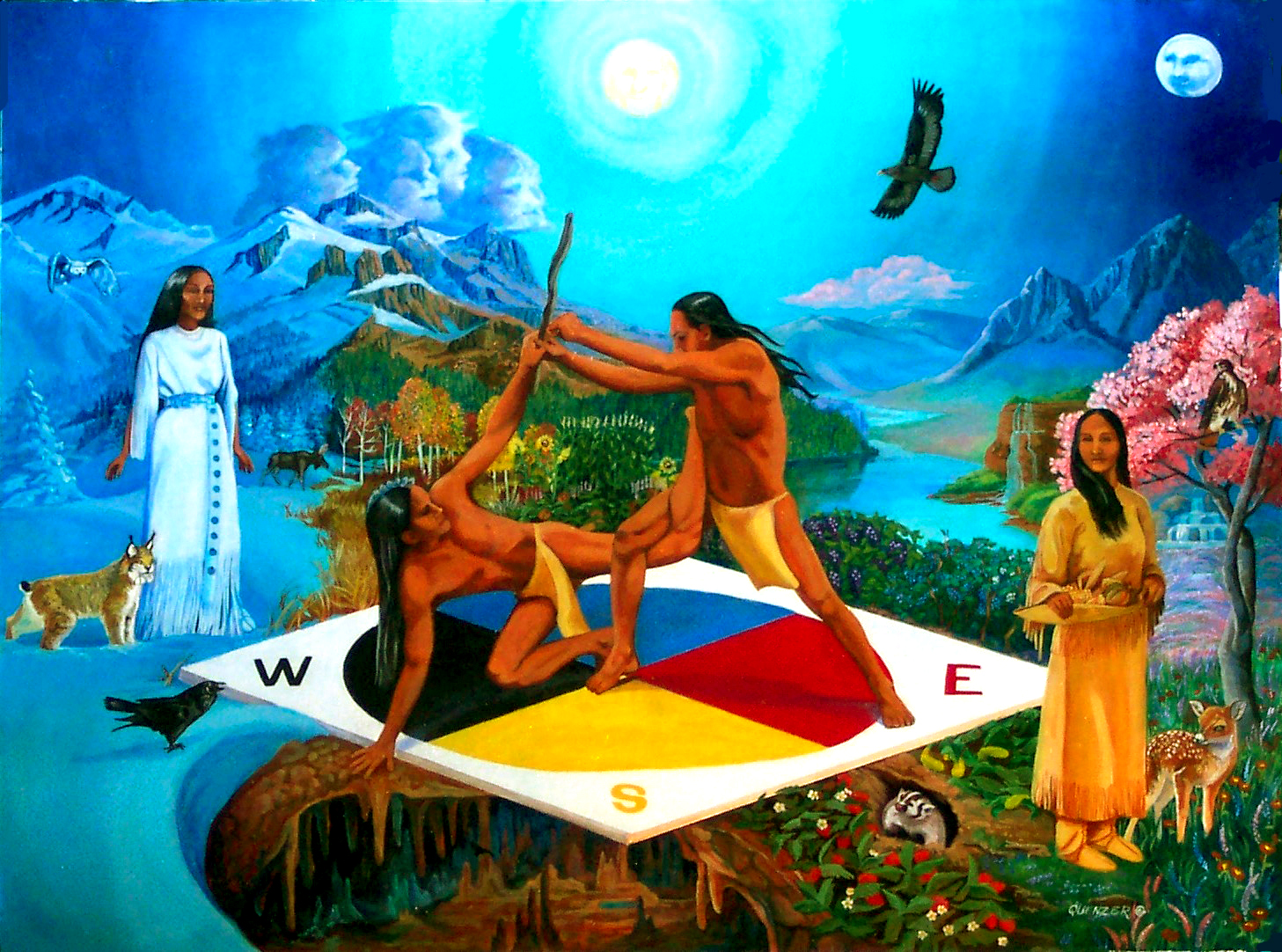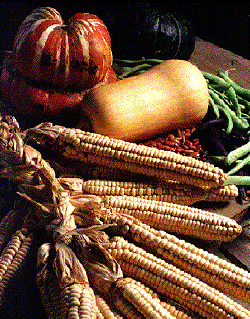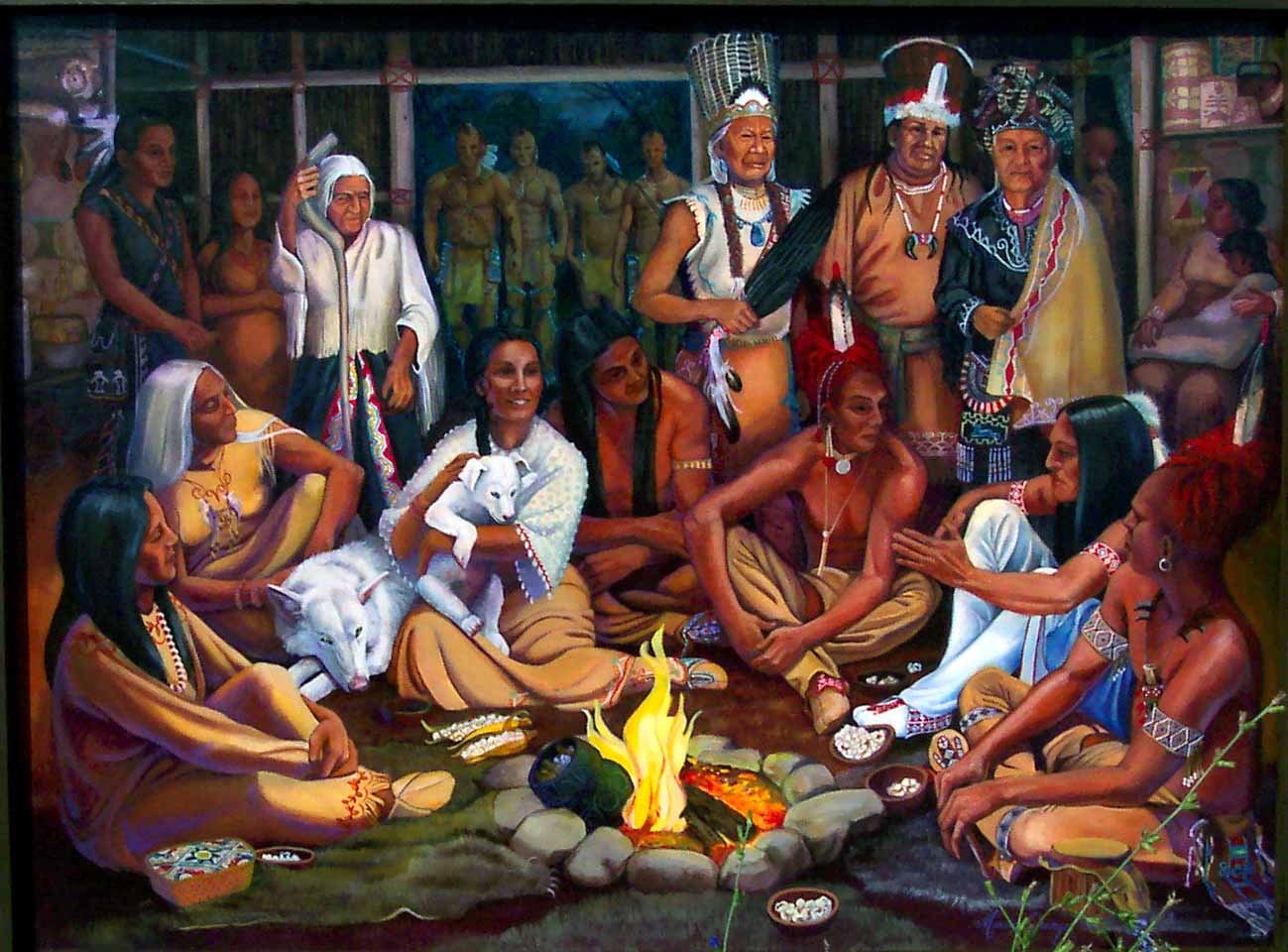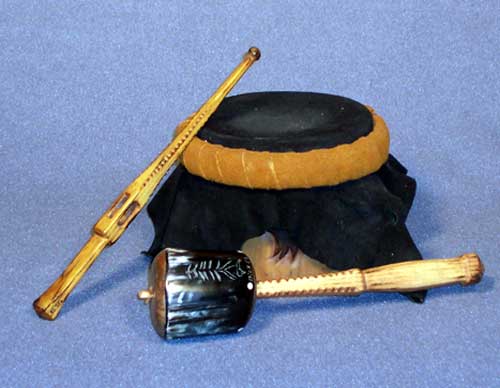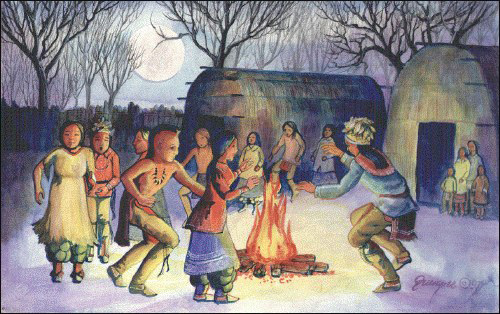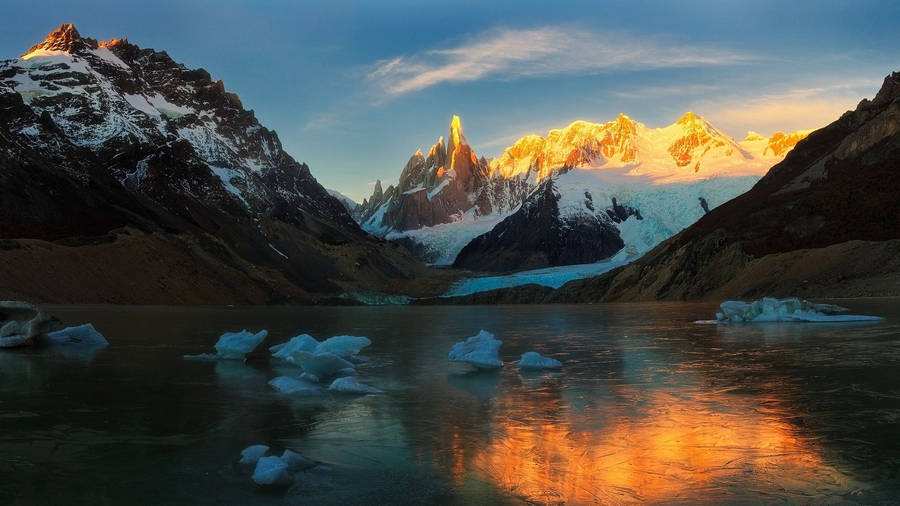The area they live in is very beneficial for growing crops so it is very desired by other tribes and is shared with other tribes in some places. The setting was more rural than urban before as there were five, now later six tribes within the Iroquois. The total population in the 1980s was said to be around twenty thousand! They had around a few hundred people in each village so it wasn't too isolated but food didn't have to be fought for too much either. The plants mainly used by the Iroquoian tribe were corn, squash, and beans. The animals in the area consisted of black bear, elk, deer, rabbits, and birds, and fish. They had a huge variety of things at their reach. The main environmental stress, like mentioned before was the climate change when it would either snow or be extremely hot for their crops to be able to withstand and for theirselves as well. They adapted to this by building houses called longhouses that were huge and kept them safe from sun exposure or snow storms.
Adaptation:
One of the physical adaptations of the Iroquoian tribes was their strength. They had to be strong to be able to build the longhouses and keep themselves out of harms way.
The other physical adaptation would be their build. They looked physically fit with lots of muscles and were not overweight but not underweight so that they would have enough meat on them to survive winters but not too much that would hold them back when carrying logs for building houses. Some of the cultural adaptations was that women were helpful in regard to planting the crops or the "Three sisters" and men with their strong builds, were able to provide shelter. The third cultural adaptation is that they would create chimneys for their longhouses so the fires could be inside to keep them extra warm and so the wind would not blow it out when they cook their food and to preserve crops they hung them from rafters and the ceiling as well as containing them in things with lids.
Language:
The most common among languages used between the different tribes in the Iroquois Nation, is Mohawk. This is the most common because it is generally used at religious festivities and men use this alot because it is spoken most at Great Councils. The other six languages are Cayuga, Tuscarora, Onondaga, Seneca,Oneida, and another popular one, Cherokee. Most Iroquoian Indians can speak more than one of these languages to communicate with the other tribes. There is a written version of this language as I have shown on the photo above. There are a lot of words that have been taken from this language and used to name things, like bayou, caribou, jaguar, and hammock. This language when written can be puzzling in the design for those of another cultural background.
Gender Roles:
There are two gender roles in this culture, the male and female roles that is. The typical roles you see in most other cultures are also apparent here but with some differences as well. The women are the ones who plant the crops and tend to them, as the men go out to hunt. The difference in this culture is that both roles will at times weave items like a boat. This culture also sees the women to have superiority or power. The chiefs of the clans may have all been men, but they only received that power by being elected by women. Roles involving any form of ritualistic performance or art of some sort were intertwined and done by male and female. The gender roles were strict in that they were never to be crossed over really but there were not really any repercussions heard of against it. Maybe this is because no one felt the need to switch roles as they felt it was the way things should be. Children learned their roles right away by the boys going to hunt with the men while the women were farming.
Subsistence:
The subsistence patterns used most frequently were hunting/gathering and slash and burn or horticulture methods, they now tend to live more similar to an American lifestyles, as well as Canadians, the two countries in which they reside. The food items within their diet consists of an abundance of things including fish, berries, black bear, elk, deer, rabbits, and the "Three Sisters"; beans, corn, and squash. The food stayed available year round for hunting and planting because the soil is always fertilized due to the constant rainfall as well as the animals always have vegetation in their environment so they will stay nearby for them to hunt. They always have a great supply of food to live off of and this may add to why they are so physically balanced. The veggies are providing by the women who care for them and the animal meat and fish as well as berries are provided by the men who are strong and physically built to go hunting for their family's. Most of their food is always obtainable and they live a very healthy lifestyle in regards to their diets.
Economic System:
The Iroquois did have a surplus of crops because of the flooding that kept them alive and flourishing. These surplus crops and meat they had were stored away in clay pots so that they would survive the cold months. This also was in case of a freezing out or dry spell so that they were not left with nothing if other crops were to perish too soon. The specialization in labor is clear in the Iroquois nation because the women were to gather food, cook, clean, tend to children, and stay at the longhouses for supervision and care for crops and children there. Men were to go hunting, fishing, be the ones to do the trading, and to go to war if need be. This tribe does in fact participate in the redistribution of goods. This can be done by providing other tribes with something such as a peace offering that is usually reciprocated, or by trading. Trading was done with crops for other goods or with their form of currency which is referred to as wampum. Wampum is a shell bead that was used as a form of money to trade it for other things like crops. It was valued so much that it was sometimes inserted into artwork. Their way of trade was beneficial to everyone because by trading they were all getting something they had wanted but in other ways it comes with a price because if you use too much of your crops for trading then you may not have enough for your own tribe.
Marriage:
The Iroquois Indians' way of marriage was monogamous in that they got married based on mutual consent and not by arrangement or for royalty. The Iroquois did not embrace marriage to parallel cousins but when it came to cross cousins it has been done to keep alliances within tribes for safety reasons. Their was no trading involved in marriage from what I have read so the values of each participant of the marriage were to be valued mostly at an equal amount, though women were able to break off the marriage whenever they felt right and the men had to leave their clan's once married to live with the woman's clan and if they were to divorce the man would have to leave the longhouse of that clan. As mentioned earlier they did not encourage incest taboo's but were not opposed when it came to cross-cousins. Regarding homosexual relationships it was unclear.
Kinship:
The kinship of the Iroquois Indians culture is of matrilineal descent pattern and this shows that the women are valued more as the men are always to leave their own clans for their partner's, meaning all the women stay in their own clan's and their maternal line is all connected. The male descent lines are not focused on much since they are not part of the clan. If the mother has a brother in their clan that is not married then he may be valued more than a father since he is by blood part of the clan. The one who possesses the most power within the family would be the oldest maternal relative since the role of authority is passed through the maternal line. Men don't carry any possessions with them other than the simple necessary ones for survival so the important possessions are passed down the matrilineal descent line as well. The naming patterns within my culture are somewhat strange. The sister of an ego's mother would be called mother as well. The brother of the ego's father would be called father and the parallel cousins were referred to the same as siblings, whereas cross-cousins are just referred to as cousins.
Social Organization:
I believe that the Iroquois Indians are that of a somewhat stratified and egalitarian culture. In regard to being egalitarian, everyone is mainly treated equal but the women hold a higher social power because of the descent pattern but this is just in a way of being respected a great amount as the men are treated mostly equal. The Iroquois are that of a stratified class when it comes to genders because women get to have the authority in keeping their marriage or not or deciding the chief, but they are egalitarian in how they live. Women have their tasks, and so do men. No task is said to be of a higher class than the other, it is just part of their lifestyle to help each other out.
Political Structure:
Chiefs are elected by the women of the tribes and this is part of the political structure. The women can veto any law of the Chief that is made as women hold most power. On a more vast political view, the Iroquois created a league of nations into one with those five tribes at the start that established a bicameral legislature where two tribes were in one "house" and two other tribes in another with a middle man tribe to veto any laws that seem out of place. representatives were chosen by clans and decisions were made by the Great Council. The Iroquois constitution inspired America and Canada in their laws that were written. For breaking laws in regards to blood shed, you could be banished or exiled from the tribe in such a scenario.
The Role of Violence:
The Iroquois desired to have peace with all mainly as a goal though violence did play a part when it was instigated by others. When this would occur a lot of blood could be shed on account of the Iroquois tribes but only because their much more toned physique than maybe an American or Canadian might of had. The effects of violence are seemed to be very negative in this culture in that they only try to move towards peace mainly, shown by the peace treaties they have with everyone. But if something was unjust regarding a political issue or regarding their goods and trading then this may cause an uproar because it is based on their survival.
Religion:
The Iroquois religion does not have a distinct name but they praise a figure known as the "Great Spirit" kind of like Christians praise God. They are polytheistic yet they tend to only worship the "Great Spirit". The story behind how they came to be is different within some tribes but majority say that a deity named Sky Woman had created the Earth and that her sons created all the bad and good in the world. One son represented the natural creations that were helpful to our survival while the other represented natural creations that were detrimental to it. There are six major ceremonies for the Ioquois religion, they are called Maple, Planting, Strawberry, Green Corn, Harvest, and Mid-Winter or New Year's festival. They are believed to help farming, curing illness, and for Thanksgiving. This culture could function without this religion but they strongly decide not to because it gives them a sense of hope and peace to hold onto which is sometimes needed to get by and survive the hard trials.
Art:
(Artwork) The most commonly used artwork would have been beads. The Iroquois would add beads to clothing, bags, and paintings even. These beads (alot of the time wampum beads), were seen as currency but seen as of more importance artistically and contributed greatly to the whole culture.
(Music) The most common form of music would be chanting, flutes, and drums. This form of music contributed to story telling and connecting with their Deity. They would do this around fire and the men sometimes would use flutes to impress women they liked.
(Performance) Dancing was used for rituals of trying to speak to the Great Spirit in accompaniment with the music such as the form of music above. This contributed to their fun and spiritual gatherings and to their strength in their belief that it could help cure illness or help with farming.
(Religions Art) I would say most commonly referred to as religious art is the ritual dancing and chanting but some religious art is shown through items like the faceless doll that tells of a story of how her face was taken by their God because she was too consumed in her appearance and this is how they believe a lesson was given regarding not being so conceited and only focusing on your looks.
Cultural Change/Conclusion:
The culture of the Iroquois have since been majorly effected by other cultures such as the American and Canadian cultures, which is expected. They have adapted to their living style that has changed. They use modern day materials just as we do and don't have to hunt or grow their own food to eat anymore but they still have the option to. Some still live on the Reservation but there are also a lot that don't anymore. A lot of the Iroquois members have gotten jobs outside there Reserve and are living just like the rest of us. Some of the positives from this change is that they don't have to struggle in the cold looking for food to catch or risk their health to survive anymore. They also have the help of many modern day medicines and vaccines as we do. The negative may be losing a lot of their original culture rituals but this does not mean they have lost it all. I believe that they are healthy, thriving, and holding onto their original culture as much as the rest of us do. They still celebrate special days, still participate in important ceremonies every year but just not everyday, just like we celebrate our holidays. The Iroquois influence on today's culture is the same as others. They add on more stories in literature, they add on more sports to our lives, and more forms of dance and more ways of religion that is just like any other culture. I wouldn't say it impacts us more than other cultures though because I believe all cultures impact each other at some point or another and always learn something new in the process!
BIBLIOGRAPHY
Borade, Gaynor. "Iroquois Tribe: Religion and Culture." Buzzle. Buzzle.com, n.d. Web. 02 June 2016. <http://www.buzzle.com/articles/iroquois-tribe-religion-and-culture.html>.
Reid, Gerald. "Iroquois." Encyclopedia of World Cultures. 1996. Encyclopedia.com. 1 Jun. 2016<http://www.encyclopedia.com>.
"Climate: Iroquois." - Climate Graph, Temperature Graph, Climate Table. N.p., n.d. Web. 02 June 2016. <http://en.climate-data.org/location/133812/>.
"Iroquois - Religion and Expressive Culture." Religion and Expressive Culture. N.p., n.d. Web. 02 June 2016. <http://www.everyculture.com/North-America/Iroquois-Religion-and-Expressive-Culture.html>.
Brandão, José António, and René Cuillerier. Nation Iroquoise: A Seventeenth-century Ethnography of the Iroquois. Lincoln: U of Nebraska, 2003. Print.



